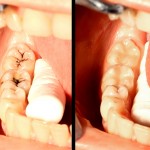
The introduction of self-adhesive flowable composite that are able to bond to enamel and dentine without additional adhesives offer the potential of fewer clinical steps reducing chairside time. Self-adhesive flowable composite is based on a number of specific acidic monomers eg , glycerophosphate dimethacrylate (GPDM), 4-methacryloxyethyl trimellitic acid (4-META), and methacrloxydecyl dihydrogen phosphate (MDP). However, in-vitro tests show that self-adhesive flowable composites (SAFCs) have lower bond strength and higher microleakage scores. But perform better in other aspects (surface texture and colour stability).
The aim of this review was to compare the clinical performance of self-adhesive flowable composites (SAFCs) and flowable composites (FCs) in permanent teeth with occlusal cavities.
Methods
A protocol was registered in the PROSPERO database. Searches were conducted in the PubMed, Embase, Cochrane Central Register of Controlled Trials (CENTRAL), Web of Science (WOS), and Scopus databases. Randomised controlled trials (RCTs) comparing SAFC and FC restorations for occlusal cavities in permanent teeth with at least 12 months follow up were considered. Two reviewers independently selected studies extracted data and assessed risk of bias using the Cochrane ROB Tool 2 for RCTs. Disagreements were resolved by discussions with a third reviewer. Restoration outcomes were dichotomised as either success or event according to the modified USPHS criteria. Meta-analysis was conducted with relative risk (RR) and 95% confidence intervals (CI) being calculated for each study. The certainty of evidence was assessed using the Grades of Recommendation, Assessment, Development, and Evaluation (GRADE) approach.
Results
- 5 RCTs (4 parallel, 1 split mouth) involving 138 patients (339 restorations) were included.
- 1 study was considered to be at low risk of bias with 4 having some concerns.
- Few events were reported for the outcomes of retention, secondary caries, and postoperative hypersensitivity. 1 study reporting no-significant deference for retention between SAFC and FC
- FCs demonstrated better marginal adaptation at one-year recall RR = 4.46 (95%CI: 2.32 to 8.58) [3 studies] with etch-and-rinse mode FCs demonstrating superior marginal adaptation at the two-year recall, RR = 3.21(95%CI: 1.50 to 6.83) [4 studies].
- Etch-and-rinse mode FCs demonstrated superior marginal discoloration at the two-year recall, RR = 3.40 (95%CI:1.10 to 10.48) [4 studies].
Conclusions
The authors concluded: –
Regarding the retention, secondary caries, marginal discoloration, and postoperative sensitivity outcomes, there were no significant differences between SAFCs and FCs in occlusal cavities. Although FCs applied with the etch-and-rinse mode showed superior marginal adaptation compared to SAFCs at two-year follow-up, clinicians could consider SAFCs as an alternative material for occlusal cavities in permanent teeth. However, further high-quality clinical trials, such as multicentre RCTs with large sample sizes, are still needed to provide solid evidence to support the use of SAFCs for direct restorations.
Comments
The authors registered their review on the PROSPERO database. They searched a good range of databases reporting their findings following the PRISMA guidelines. Only 5 small studies were included only one of which was being assessed as being at low risk of bias. As noted by the author in 4 out of the 5 included studies the tooth and not the patient was the experimental unit. While the review found no significant differences between SAFCs and FCs in terms of retention, secondary caries, marginal discoloration, and postoperative sensitivity outcomes the limited number and quality of the small number of available studies mean the findings should be viewed cautiously. As the authors concluded more large well-conducted trials are needed to provide better evidence.
Links
Primary Paper
Liu X, Zhang R, Yu X, Hua F, Zhang L, Chen Z. Self-adhesive flowable composite resins and flowable composite resins in permanent teeth with occlusal cavities: A systematic review and meta-analysis. J Dent. 2023 Nov;138:104691. doi: 10.1016/j.jdent.2023.104691. Epub 2023 Sep 7. PMID: 37683798.
